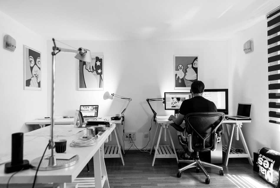Home Office Ergonomics

Working from home brings with it many challenges. As most at-home offices have recently evolved out of necessity, we’ve seen a spike in associated ergonomic injuries. This highlights the importance of setting up your home office properly.
While there is no “one size fits all” set up when it comes to working from home, there are definitely some areas you can focus on to lower your risk and avoid the common aches and pains we are noticing in the clinic.
Common complaints we are getting include neck pain, headaches, and back pain. They can all be alleviated with some simple adjustments to your desk set up at home. Here are some suggestions to help relieve some of those niggles you may have noticed creeping in.
Screen height:
the height of your computer screen can have a big impact on your neck, shoulders and back. While spending large periods of time at a desk, it’s important to try and keep the spine as upright as possible to maintain your naturally occurring spinal curves. Those natural curves help distribute the mechanical stress throughout your whole spine. By adjusting your screen height so that your head is tall and your back is straight, you can avoid some major neck, shoulder and back pain.
- Work from home tips: The “ideal” screen height is at eye level with the top of the monitor. While some monitors might not be easily adjusted, simply sliding a book/books under the monitor could help to bring up the screen height. Sometimes adjusting the chair and desk height combination might also allow for the correct height. Look for ways to adjust or swap chairs and tables to enable a better screen solution.
Chairs
Most home office chairs are okay for a temporary ergonomic solution, but when more and more time is spent working from home it can start to become a problem. The most common complaint we see from incorrect chair selection and use is pain in the lower back. There are so many variables to consider for your chair with height, seat tilt, back tilt, and depth all playing a role in your ergonomic positioning and comfort. The one that is the easiest to check and modify on most chairs to relieve lower back pain is chair tilt. The tilt of a chair is responsible for the pelvic positioning which has a domino effect on the spine.
- Work from home tips: If your chair doesn’t adjust the tilt of the seat there are still ways you can work around it. Even if you’re dealing with a dining table chair, simply place a folded towel, small pillow, old t-shirt, or anything soft at the back of the chair. This will support your pelvis in more of an anterior tilt position that can help to redistribute some of the pressure on the lower back. If your chair does tilt, gently tilt it forward so it feels like the chair is almost encouraging you to slide off.
Not moving
Move it or lose it! The biggest enemy when it comes to many musculoskeletal issues is immobility. The body craves movement. This is what helps it generate and distribute the naturally occurring lubrication of our joints to keep us feeling loose and nimble. When we are inactive for any period of our time our body stops producing this lubrication. This leads to joint stiffness which leads to aches and pains. Working from home can mean you don’t have incidental activities like commuting to work, work meetings, and coffee breaks, and most of a working day can be done with little need to move.
- Work from home tips: MOVE. Although the easiest of all the tips, it is probably the one that is the least used. Create a routine that involves going for planned walks throughout the day or getting up from your desk to do 10 squats or push-ups at different intervals throughout the day. It may not seem like you have time but all it takes is 2 minutes and your joints will love you for it.
If exercise isn’t your thing then just change up the working situation from sitting, to standing, to pacing the hallways, to working at the kitchen bench. Changing up the body’s position is a bare minimum solution, but it can be enough to alleviate some joint stiffness or pain that you may be developing.
It is important to remember that these are just suggestions and may not work for everyone, but it won’t hurt to try them if you’re looking for some ways to help resolve that niggle.
We hope these tips help you stay healthy, well, and comfortable while working from home. Let us know if you tried any of our tips and if they helped you. Don’t forget, we are always here to treat any of those aches and pains that might not be so easily corrected.





